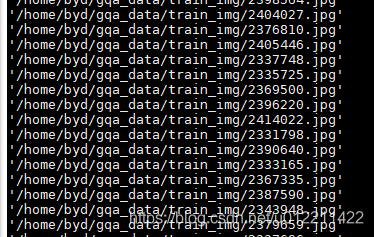常见的代码里的存储网络参数,和load 网络参数
def save(self, name):
torch.save(self.model.state_dict(),
os.path.join(self.output, "%s.pth" % name))def load(self, path):
print("Load model from %s" % path)
state_dict = torch.load("%s.pth" % path)
for key in list(state_dict.keys()):
if '.module' in key:
state_dict[key.replace('.module', '')] = state_dict.pop(key)
self.model.load_state_dict(state_dict, strict=False)
简单的权重初始化操作
def init_bert_weights(self, module):
""" Initialize the weights.
"""
if isinstance(module, (nn.Linear, nn.Embedding)):
# Slightly different from the TF version which uses truncated_normal for initialization
# cf https://github.com/pytorch/pytorch/pull/5617
module.weight.data.normal_(mean=0.0, std=self.config.initializer_range)
elif isinstance(module, BertLayerNorm):
module.bias.data.zero_()
module.weight.data.fill_(1.0)
if isinstance(module, nn.Linear) and module.bias is not None:
module.bias.data.zero_()model = Unet(3, 1)#,)
from torchsummaryX import summary
#summary(model, torch.zeros(5, 3, 512, 512))
for name in model.state_dict():
print(" %s : %s" % (name, model.state_dict()[name].shape))
#print(model.state_dict()[name])#这个是weight bias 对应的数值import torch
from attention_unet_multi import AttU_Net
import torchvision.models as models #预训练模型都在这里面
vgg16 = models.vgg16(pretrained=True) #加载网络结构和预训练模型
pretrained_dict = vgg16.state_dict() #返回内置预训练vgg模块的字典
#for name in pretrained_dict:
# print(" %s : %s" % (name, pretrained_dict[name].shape))
#print(pretrained_dict)
model = AttU_Net(3, 1)
model_dict = model.state_dict() #返回我们自己model的字典
#for name in model_dict:
# print(" %s : %s" % (name, model_dict[name].shape))
#pretrained_dict = {k: v for k, v in pretrained_dict.items()}
#model_dict = {k: v for k, v in model_dict.items()}
#print(model_dict) 由于我的网络的层名称与预训练模型的层名不一致,所以可以手动构造字典,进行部分参数加载
pretr = { 'Conv1.conv.0.weight' : vgg16.state_dict()['features.0.weight'],
'Conv1.conv.0.bias' : vgg16.state_dict()['features.0.bias'],
'Conv1.conv.3.weight' : vgg16.state_dict()['features.2.weight'],
'Conv1.conv.3.bias' : vgg16.state_dict()['features.2.bias'],
'Conv2.conv.0.weight' : vgg16.state_dict()['features.5.weight'],
'Conv2.conv.0.bias' : vgg16.state_dict()['features.5.bias'],
'Conv2.conv.3.weight' : vgg16.state_dict()['features.7.weight'],
'Conv2.conv.3.bias' : vgg16.state_dict()['features.7.bias'],
'Conv3.conv.0.weight' : vgg16.state_dict()['features.10.weight'],
'Conv3.conv.0.bias' : vgg16.state_dict()['features.10.bias'],
'Conv3.conv.3.weight' : vgg16.state_dict()['features.12.weight'],
'Conv3.conv.3.bias' : vgg16.state_dict()['features.12.bias'],
'Conv4.conv.0.weight' : vgg16.state_dict()['features.17.weight'],
'Conv4.conv.0.bias' : vgg16.state_dict()['features.17.bias'],
'Conv4.conv.3.weight' :vgg16.state_dict()['features.19.weight'],
'Conv4.conv.3.bias' : vgg16.state_dict()['features.19.bias'],
}
model_dict.update(pretr)
model.load_state_dict(model_dict)将图片尺寸满足要求大小的进行筛选,主要用于图像分割中图片大小不一的问题,为了裁剪尺寸准备
import os
import shutil
import torchvision.transforms as transforms
from PIL import Image
dir_path = './data/VOC2007/SegmentationClass'
for root, dirs, files in os.walk(dir_path):
#list1 = ['./data/VOC2007/JPEGImages/'+n[:-4]+'.jpg' for n in files]
list2 = [dir_path+'/'+n for n in files]
#print(list2)
file_dir = './data/trans/'
for x, d in enumerate(list2):
#print(d)
img = Image.open(d).convert('RGB')
w, h = img.size
if w < 300 or h < 300: #过滤长宽分别小于300的图片
continue
else:
dd = str(file_dir+d[33:])#将长宽满足的图片拷贝到另一个文件夹下
shutil.copy(d, dd)
将图片重新编码为了dataloader类
import os
import shutil
import torchvision.transforms as transforms
from PIL import Image
dir_path = './data/trans'
for root, dirs, files in os.walk(dir_path):
#list1 = ['./data/VOC2007/JPEGImages/'+n[:-4]+'.jpg' for n in files]
list2 = [n[:-4] for n in files]
print(list2)
for index, x in enumerate(list2):
#拼接出要存放的文件夹的路径
file_dir = './data/voc2'+'/'+str(index).zfill(3)+'.jpg'
#将指定的文件file复制到file_dir的文件夹里面
shutil.copy('./data/VOC2007/JPEGImages/'+x+'.jpg', file_dir)快速生成序列文件夹,为了图像分类
import os
base = r'F:\FFOutput\test\noc' #新建文件夹的路径
i = 1
while i < 80: #新建1-80: 79个文件夹
file_name = base+str(i) #以noc加数字为文件夹名称
os.mkdir(file_name)
i=i+1
————————————————
原文链接:https://blog.csdn.net/qq_38143062/article/details/85721402图像的复制粘贴
import shutil
src='D:/zzz/bg.jpg'
dst='E:/tmp/bg.jpg'
shutil.copyfile(src,dst)
print('ok')结果截图
linux 文件个数
find . -type f -print | wc -l
pytorch实现用Resnet提取特征并保存为txt文件的方法_-互联网文档类资源-CSDN下载
我将上面分享的代码进行复制到这边来,感谢上面链接的分享
import os.path
import torch
import torch.nn as nn
from torchvision import models,transforms
from torch.autograd import Variable
import torchvision
import numpy as np
from PIL import Image
features_dir = './features'
img_path = "/home/byd/demo/COCO_val2014_000000218224.jpg"
transform1 = transforms.Compose([
transforms.Scale(256),
transforms.CenterCrop(224),
transforms.ToTensor()
])
img = Image.open(img_path)
img1 = transform1(img)
model = torchvision.models.resnet101(pretrained=True)
model_extractor = nn.Sequential(*list(model.children())[:-1])
for param in model.parameters():
param.requires_grad=False
x = Variable(torch.unsqueeze(img1,dim=0).float(), requires_grad=False)
y = model_extractor(x)
xx = y.data.numpy()
print(xx.shape,xx.device)
print(type(xx))






















 1万+
1万+











 被折叠的 条评论
为什么被折叠?
被折叠的 条评论
为什么被折叠?








